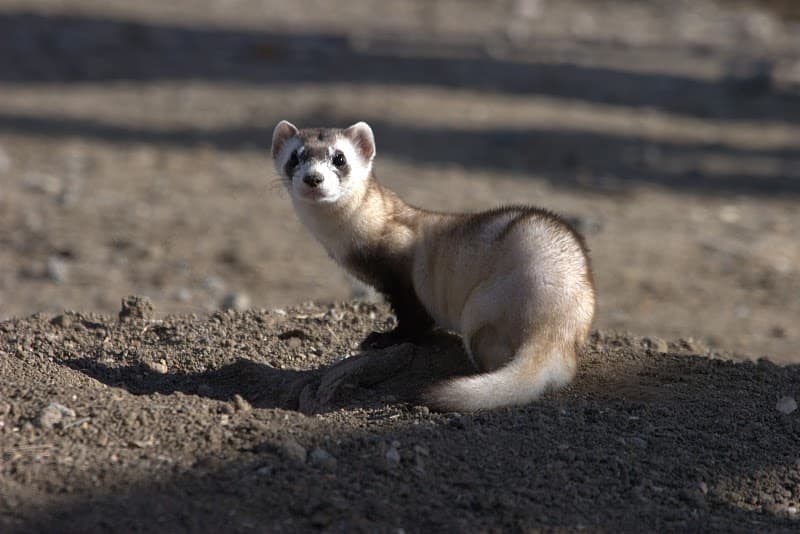As researchers clone ferrets, Wyo scientists emphasize habitat
In late February, the San Diego Zoo announced news that took the endangered species world by storm: Researchers successfully cloned the first black-footed ferret. Not only did she — the creature’s name is Elizabeth Ann — survive, but she represents the first successful cloning of a native endangered species in North America.
The announcement made headlines across the country, from National Geographic to the New York Times. Here in Wyoming, enthusiasm among conservationists and wildlife managers is high, but perhaps slightly more tempered.
“It’s a very interesting bit of news,” said Zack Walker, Wyoming Game and Fish Department’s nongame supervisor. “More genes could possibly help them survive, but once they’re ready to come out in the field, it’s really the landowners and partnerships that are helping in the state. It’s the habitat.”
Wyoming has two populations of black-footed ferrets, one in Shirley Basin that appears to be stable, and another near Meeteetse that was down to a single individual last year. The challenge for that population is less genetics than it is sylvatic plague — though researchers say a more diverse gene pool could, in the long term, help build disease resiliency.

“Maintaining and increasing wild populations and suitable habitat continues to be essential for black-footed ferret recovery and will remain a priority for the Service,” Noreen Walsh, director of the U.S. Fish and Wildlife Service’s Mountain-Prairie Region, said in a news release. “Successful genetic cloning does not diminish the importance of addressing habitat-based threats to the species or the Service’s focus on addressing habitat conservation and management to recover black-footed ferrets.”
Success, with an asterisk
The black-footed ferret story is well-known in Wyoming.
The creatures were believed to be extinct until one day in 1981 when a ranch dog named Shep carried a dead black-footed ferret to the rancher’s porch. The rancher took the dead critter to a taxidermist, and biologists subsequently monitored the newfound population. A handful of years later, ferret populations crashed and experts swooped in, sequestering the remaining 18 before the species was lost forever. Fewer than 18 actually reproduced, which means all black-footed ferrets in the wild are closely related.
Black-footed ferrets were relocated to sites across the West. Their captive breeding story has been a remarkable success, with some caveats. Fewer than 500 individuals exist in the wild, and because of limited genetics, they’re even more susceptible to disease and other problems caused by inbreeding.
Enter the San Diego Zoo’s Global Frozen Zoo.
The Frozen Zoo, as it’s called, was created decades ago to house cells from endangered species. In 1988, Tom Thorne, a Game and Fish disease specialist who led the charge to save the ferrets, sent tissue from a female named Willa to the Zoo. Willa had no living descendants, which means her genome has “three times more unique variations than the living population,” the USFWS release states.

Researchers with the San Diego Zoo worked with Revive & Restore, an organization that focuses on restoring endangered or even extinct species, ViaGen Pets & Equine, which specializes in cloning and the Fish and Wildlife Service.
Scientists used Willa’s cells to create a frozen embryo, then implanted it into a domestic ferret surrogate. Elizabeth Ann was born on Dec. 10. Later testing showed she is a genetically pure black-footed ferret.
Habitat, disease and ferret-sniffing dogs
On the ground in Wyoming, the ferret news is more mixed.
The Shirley Basin population — a group of about 30 ferrets burrowing underneath and scurrying above the windswept high plains of southeastern Wyoming — dropped in the mid-2010s, Walker said. The population then rebounded, slowly, and biologists believe it is now likely more stable.
The problem with Shirley Basin though, is trying to survey a small, nocturnal animal over such a large expanse. This summer, Game and Fish Department officials plan to use ferret sniffing dogs to help them locate animals.
“In order to consider ferret populations a success in the state, we have to meet certain numbers,” Walker said. “And that means we have to know where they’re at and how they’re doing.”
The story in Meeteetse is less positive. After a relocation of 35 ferrets in 2016 — the 35th anniversary of their discovery — the population crashed likely due to a bout of plague. The fleas that carry plague tend to thrive in prairie dog colonies, and black-footed ferrets require prairie dogs for their food and shelter. Canine distemper is also a lethal threat to the endangered species. Biologists vaccinate black-footed ferrets against both of those diseases when the creatures can be caught in the wild.
Researchers released another 19 ferrets in 2020 near Meeteetse. They will survey again this summer to see if any are still surviving.
But beyond disease, conservationists say habitat is going to be one of the biggest hurdles to black-footed ferrets leaving the endangered species list.
“This research is significant, but equally important is protecting habitat for the DNA to evolve in the wild,” said Chamois Anderson, senior representative of the Rockies and Plains Program for Defenders of Wildlife. “For ferrets to reproduce in the wild is where that DNA can really evolve with natural conditions in large-scale habitat.”
A recent decision by the U.S. Forest Service to allow increased killing of prairie dogs in the Thunder Basin National Grassland will likely limit black-footed ferret expansion in Wyoming, she said.
For Bob Oakleaf, Game and Fish’s nongame supervisor in the early 1980s when black-footed ferrets were rediscovered, everything that could help ferrets matters.
“It’s another one of those tools, that’s great we’ve got it,” he said. “It’s just such a hard thing. Where do you spend your money and effort? It’s really cool there are people and funding sources to devote to that kind of effort.”
Photo by USFWS



